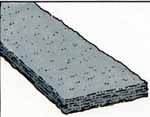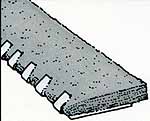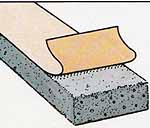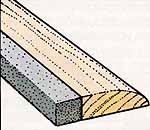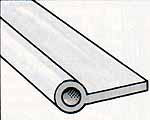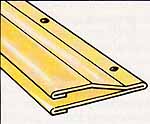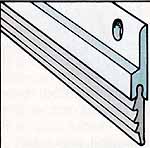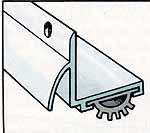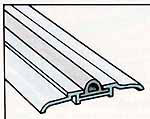Your house is your protection against the elements. When winter’s cold and summer’s heat leak in, they steal your comfort along with your energy dollars. It takes just a little investment and know-how to plug those leaks.
As you may have discovered when you did your energy audit, your house is an integral system in its own right. Just as one problem can lead to another (for example, a leaky roof may lead to rotting walls), so one solution encourages another (to continue the example, fixing that leak in your roof will not only help prevent your walls from rot ting, but it will also keep the insulation from spoiling).
Maintaining your house in good repair will make your life more comfortable and also save you energy and money, both now and in the future. After all, a solid house is a far better investment than a rickety one. and if you undertake some of the maintenance and repair work yourself instead of hiring it out, you may find that your house becomes a new source of pride and satisfaction.
Your house protects you from the elements—the roof and walls keep cold, heat, rain, wind, dust, and so forth at bay. However, you wouldn’t want your house to seal you off from the outside world entirely, so there are windows to admit air, sunlight, and views; doors to let you pass in and out of your protective shell; and chimneys and vents to encourage air circulation and help maintain proper temperatures.
Weatherstripping
Weatherstripping is one of the best things you can do for your house. It involves applying materials to the sides and insides of doors and windows to create tighter seals with their jambs and casings. A good job of weatherstripping will keep unconditioned air out and conditioned air in. But beyond that, there are additional advantages. Because weatherstripping is essentially a seal, it also reduces the infiltration of dirt, dust, noise, and moisture; absorbs some of the shock to glass components when you slam a window or door; helps keep windows and doors from rattling in high winds; and cuts down on drafts.
There are two easy ways to tell whether a particular window or door needs to be weatherstripped: stand in front of it when there’s a breeze outside; or simply look at it. If you can feel a draft while standing indoors in front of a closed door or window, you need weatherstripping. If you can see that light is coming in around the door, or that there’s no stripping already in place, or that the existing stripping is cracked, damaged, or coming loose, you don’t have to wait for a windy day to find out that you have an infiltration problem.
If you plan to do a complete weather stripping job in your house, don’t limit yourself only to the obvious. For best results strip not only those windows and doors that lead outside, but also doors that lead to any unheated space (such as a garage, porch, basement, attic, crawlspace, or unheated—or uncooled— spare room) and unusual “windows” (such as skylights). Keep in mind that weatherstripping does not take the place of storm windows and storm doors. In fact, it’s a good idea to weatherstrip them, too.
All weatherstripping materials are available in kits that include hardware; or you can buy the component parts separately. To find the total length of weatherstripping you’ll need, measure your window or door frame carefully. If you’re buying stripping materials for more than one door or window at a time, make a list of how many strips of each length you will need for every door or window. Then, if you’re buying components, simply purchase the total amount and cut it up later. Measure and cut carefully, so that you don’t end up with a little too much or a little too little.
Before you begin, make sure you have sufficient weatherstripping material, a hammer, tin snips, a tape measure, and a screwdriver or putty knife. Make sure all the channels are clear of flakes of old paint and other debris.
• Types of weatherstripping: There are many types of weatherstripping, made of many materials and sold in a wide range of prices under numerous brand names. Some kinds of stripping are more durable than others. Sometimes the price reflects the durability, but not always. For example, self-adhering strip ping is more expensive than tack-up stripping, but it lets go faster. Some kinds of stripping, such as felt or adhesive foam tape, have to be replaced every year or two. Other kinds, such as tension strips, can last the life of your windows if they are installed correctly to begin with.
In choosing your weatherstripping, make sure you have the right kind for the job you want to accomplish. This chart will help you understand the differences between kinds of stripping. If you still have any doubts or questions after reading this section, ask the sales person at your hardware store for ad vice so that you don’t come home with exactly what you didn’t want or need.
Kinds of Weatherstripping for Doors and Windows:
Kind, Material |
Cost (approximate per linear foot) |
Installation |
Use |
Remarks |
|
5-10 cents |
Very easy. Glue, nails, or staples. |
Anywhere it will not be subjected to severe or frequent friction window (Such as channels of sashes). Best around doors and at tops and bottoms of double-hung windows. |
Should not get wet, as it may rot. Should not be dragged against hard surfaces, which may tear it. Essentially a stop-gap measure for temporary use. Will have to be replaced in 1 to 2 years under normal conditions. can't be painted. |
|
10-15 |
Same as felt. |
Same as felt. |
Same as felt, but stronger. |
|
15-20 10-15 5-10 |
Very easy. Self-adhesive or glue. |
Same as felt. |
Similar to felt, but more versatile. Can be removed easily but may also fall off easily. |
|
20c (wood); 35-70c (metal) |
Easy. Nails or screws. |
Doorjambs. |
Resilient and wears fairly well. Wood or metal parts should be painted: foam should not be painted. |
|
10-12c (hollow); 20-25c (foam-filled) |
Moderately easy. Self-adhesive or nails. |
Anywhere. Best around door-jambs, around sliding windows, where sashes meet on double-hung windows. Good at all window junctures. |
Quite durable and resilient, with-stands friction well; can compress unevenly to fill irregular spaces. Creates good pressure seal. |
|
10-12c, (aluminum); 20-25c (other) |
Moderately easy. Nails. |
All door and window junctures, especially window sash channels and outside edges of door frames. |
Easy to keep out of sight. Extremely durable. Highly efficient. Works best under tension. Does not corn- press unevenly, and will not seal irregular spaces. After installation, flanges can be pried to create tighter fit—work gently, and do not damage seal or springy quality of strip. |
|
60-70c |
Easy. Nails or screws (screws preferred). |
Door bottoms. |
Efficient, effective, and fairly durable, but inevitably visible and not especially attractive. Must be attached on side toward which door opens, and must seal with thresh old. Automatic sweeps raise up when door is opened, lower when door is closed, to avoid dragging on carpets, etc., but must not jam too tightly against threshold when door is closed, or mechanism will wear out quickly. |
|
$1.50-1.75 |
Moderately easy. Nails or screws. |
Door bottoms. |
Very efficient and very durable if installed properly, but door may have to be removed for installation. Requires good threshold for firm seal. Some models have drip caps to shed rain and keep water from running under the door. |
|
$2.00-2.50 |
Moderately difficult. Nails or screws. |
Door thresholds. |
Gasket similar to that of door shoe, but included in a metal threshold. Very efficient if installed properly, but because vinyl gasket is ex posed to foot traffic, less durable than the shoe. As with the shoe, door may have to be removed for installation. Some models have drip caps similar to those on door shoes. |
Next: How to Weatherstrip a Window
Prev: The Energy Audit
